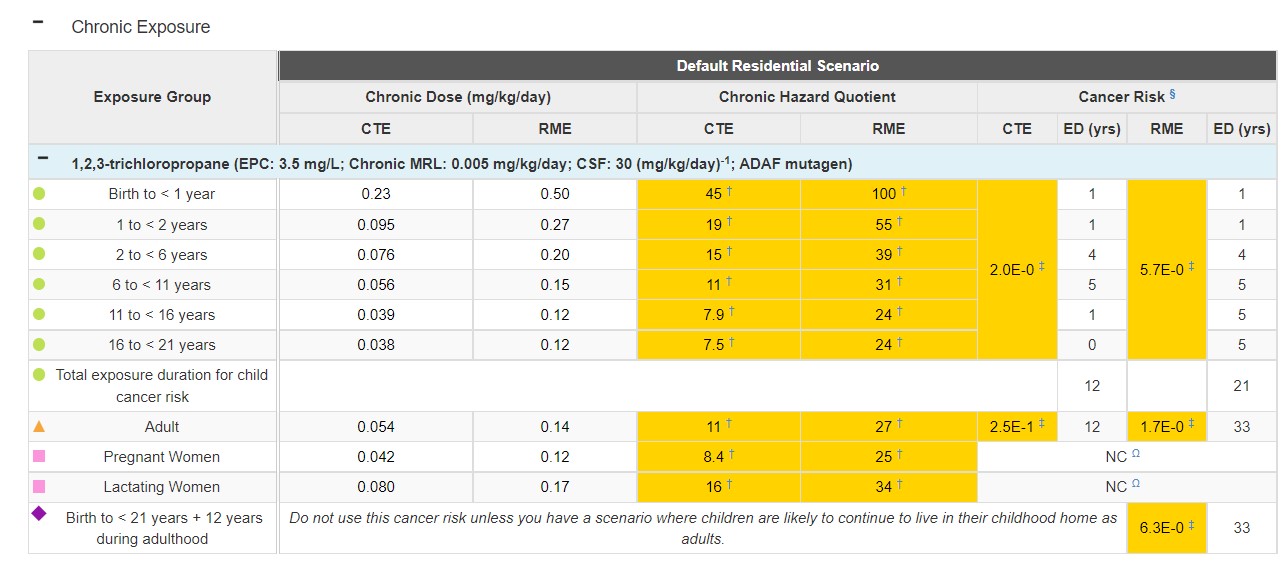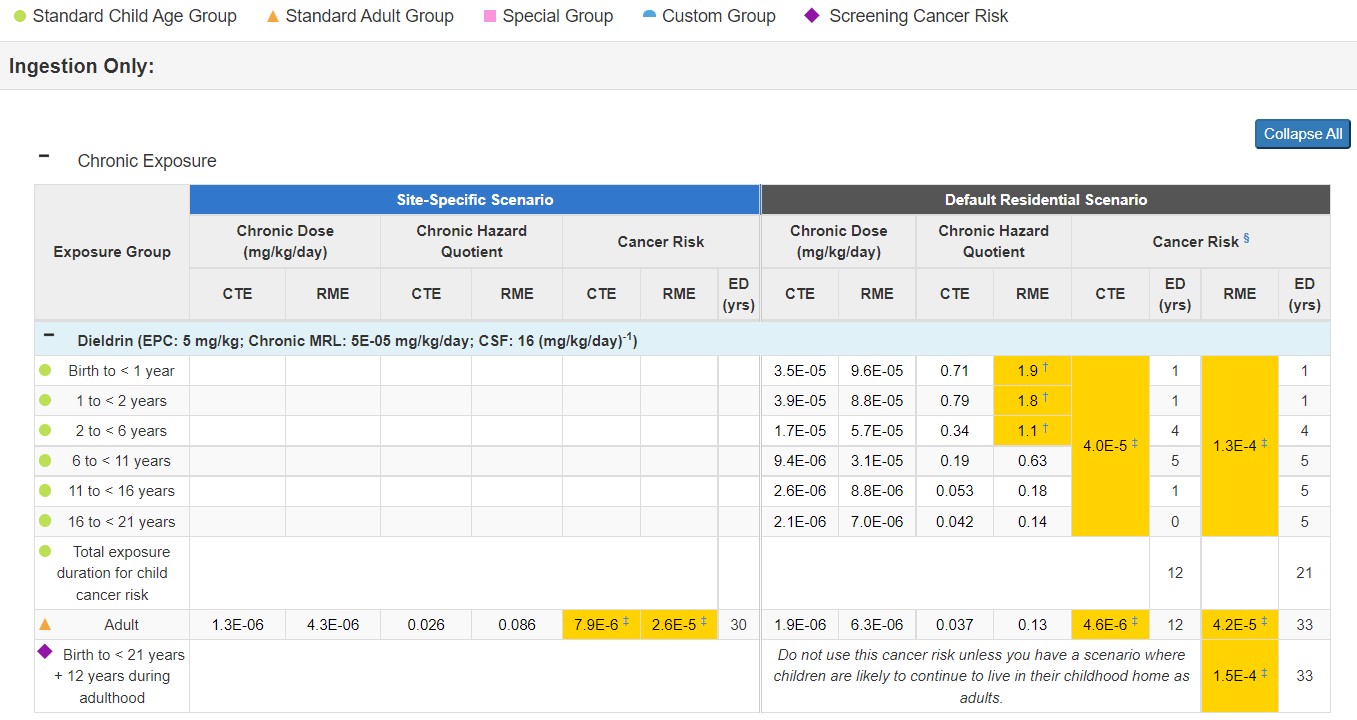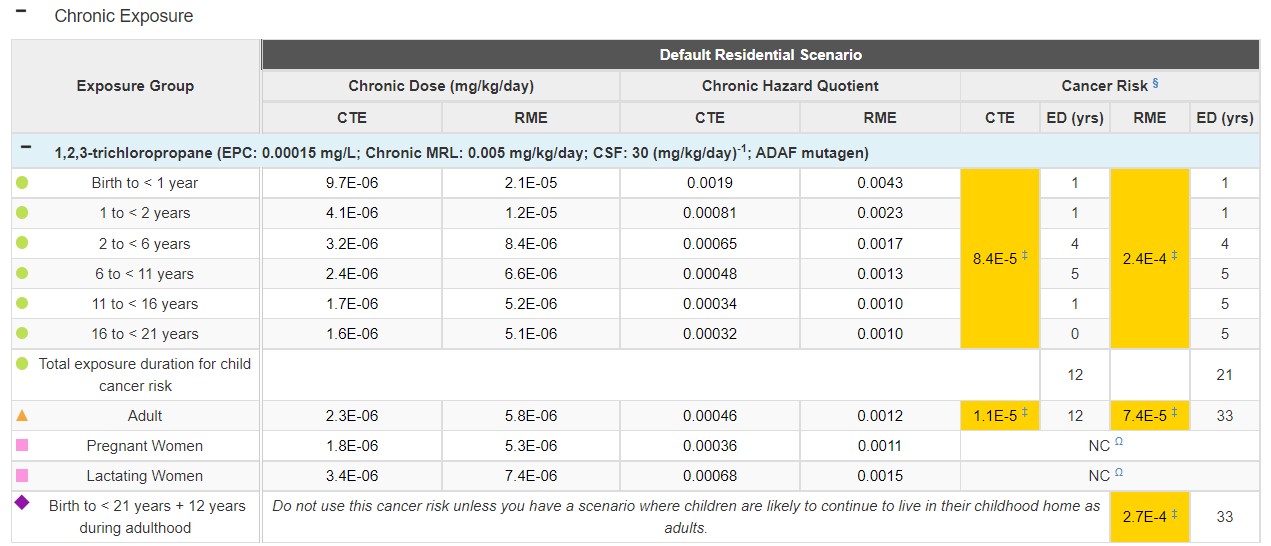Calculating Hazard Quotients and Cancer Risk Estimates
This section describes how to use exposure doses/air concentrations and health guidelines to calculate hazard quotients (HQs), and exposure doses/air concentrations and cancer risk values to estimate cancer risks (CRs).
Once you have your estimated exposure doses and adjusted air concentrations, you will use health guidelines and cancer risk values to estimate the potential non-cancer health effects and cancer risks, respectively, for each contaminant and exposure pathway.
Selecting Appropriate Health Guidelines and Cancer Risk Values
Before performing the HQ and CR calculations, you will need to determine the most appropriate health guidelines or cancer risk values, respectively, to use for evaluating your site-specific exposure doses or adjusted air concentrations. Important: PHAST will make this selection for you, but it is important for health assessors to understand ATSDR’s selection process. Different health guidelines are available for exposure routes (ingestion, inhalation), exposure durations (acute, subchronic/intermediate, and chronic), and health endpoints (carcinogenic, non-carcinogenic).
Health guidelines (used to evaluate non-cancer health effects) (see descriptions in this table) and cancer risk values (used to estimate cancer risks) (see descriptions in this table) are derived from data in the epidemiologic and toxicologic literature with appropriate uncertainty or safety factors applied to ensure they are set at levels below those that could result in harmful health effects. The values do not represent thresholds of toxicity.
Common Health Guidelines (Non-Cancer) Used by ATSDR
| Health Guidelines | Definition |
|---|---|
| ATSDR-Developed Minimal Risk Levels (MRLs) |
|
| EPA-Derived Reference Doses (RfDs) |
|
| EPA-Derived Reference Concentrations (RfCs) |
|
Common Cancer Risk Values Used by ATSDR
| EPA-Derived Cancer Risk Values | Definition |
|---|---|
| Oral Cancer Slope Factors (CSFs) |
|
| Inhalation Unit Risks (IURs) |
|
Again, remember that PHAST will select the most appropriate health guidelines to evaluate non-cancer effects and cancer risk values to evaluate cancer effects for your scenarios. However, it is important for health assessors to understand ATSDR’s selection process. The following considerations apply when selecting the most appropriate health guidelines and cancer risk values:
- Exposure route. If contaminant-specific health guidelines or cancer risk values are not available for the exposure route of concern at a site, depending on specific scenarios, health guidelines or cancer risk values developed for other exposure routes could be used. For example, since health guidelines and cancer risk values are not available for dermal contact, ATSDR uses oral minimal risk levels (MRLs) and cancer slope factors (CSFs) for ingestion exposures to evaluate dermal exposures in PHAST. When PHAST does not have available health guidelines or cancer risk values, health assessors will further evaluate those contaminants in the in-depth toxicological effects analysis. If health assessors identified health guidelines and cancer risk values from other sources (see box) for other exposure routes, before using this approach, consult with a toxicologist and the ADS group and consider the impact of extrapolating from one route of exposure to another in these cases. Exercise care when drawing conclusions from these types of comparisons, and be sure to note you used a substitute approach and indicate it could result in lower confidence in the associated results.
- Exposure duration. ATSDR develops MRLs for acute (14 days or less), intermediate (15-364 days), and chronic (365 days or more) exposures. EPA’s reference doses (RfDs) and reference concentrations (RfCs) are developed assuming chronic exposures. EPA’s oral CSFs and inhalation unit risks (IURs) are based on continuous lifetime exposures occurring from birth. See EPA’s Integrated Risk Information System for more information and specific considerations when evaluating vinyl chloride exposures. Remember that PHAST will select the contaminant-specific health guidelines that best represent the exposure duration related to your site-specific scenarios, and the appropriate cancer risk values.
Note: If ATSDR has an MRL and EPA has an RfD for the same contaminant, ATSDR typically uses its MRL. There are a few exceptions, but PHAST will automatically select the most appropriate value.
- Health endpoints. When available, select ATSDR’s MRLs. However, ATSDR selects the RfD instead of the MRL in a handful of cases, such as when the RfD is lower (more health protective) or based on newer data than the MRL. If no MRL is available for a contaminant, use EPA’s RfDs or RfCs. When available, select EPA’s oral CSFs or IURs. PHAST is programmed to select ATSDR’s preferred health guideline and cancer risk value for your scenario. Consult other trustworthy sources if no ATSDR or EPA health guidelines or EPA cancer risk values are available. There are various types of other sources. Ensure you understand how health guidelines and cancer risk values from these other sources were derived before using them in your evaluation (see text box below).
Health assessors should use the most appropriate and up-to-date health guidelines and cancer risk values. MRLs, RfDs, CSFs, and IURs are approved for use during the PHA process. ATSDR and EPA regularly update their values. The most current values to use are stored in PHAST (health assessors and those involved in the PHA process can email phast@cdc.gov for access).
Detailed information about ATSDR’s contaminant-specific non-cancer health guidelines (MRLs) is provided in ATSDR’s Toxicological Profiles. Information about EPA’s health guidelines and cancer risk values is reported in EPA’s Integrated Risk Information System (IRIS) database.
Because the mandates of different agencies may not always be strictly health-driven or consistent with the concerns of sites ATSDR works on, before choosing a non-ATSDR or non-EPA health guideline or non-EPA cancer risk value, be sure to understand its derivation, uncertainties, use, and possible limitations to ensure that it is adequately protective of public health. Also consult with a subject matter expert (SME), a toxicologist, or the ADS group before using it.
Estimating Hazard Quotients
The hazard quotient (HQ) is calculated to evaluate the potential for non-cancer health hazards to occur from exposure to a contaminant with available non-cancer health guidelines (MRLs, RfDs, RfCs).
When you have exposure doses, you typically obtain the HQ by dividing the duration-specific (acute, intermediate, or chronic) exposure dose by the non-cancer health guideline for the same duration MRL or RfD for your exposure groups of interest. When you have an air concentration, you obtain the HQ by dividing the duration-specific exposure concentration by the MRL or RfC. The box below contains the basic formula for calculating HQs using exposure doses or adjusted air concentrations.
HQ = (D / MRL or D / RfD) or (AAC / MRL or AAC / RfC)
HQ = Hazard Quotient, D = Exposure Dose (mg/kg/day), MRL = Minimal Risk Level (mg/kg/day), RfD = Reference Dose (mg/kg/day), AAC = EF-adjusted Air Concentration (µg/m3), RfC = Reference Concentration (µg/m3)
Once you have your HQ, compare it to 1. HQs less than 1 indicate a non-cancer hazard should not be an issue. When an HQ is greater than 1, retain those contaminants and conduct an in-depth toxicological effects analysis. In other words, an HQ above 1 means there is an exceedance of the non-cancer health guideline.
The example below uses the hazard quotient formula to calculate HQs.
Scenario: Let’s look back at the drinking water ingestion exposure dose example. The family was exposed daily at their home for an unknown number of years to contaminated drinking water with an EPC of 3.5 milligrams per liter (mg/L) for 1,2,3-trichloropropane. You do not know the number of residents or their ages.
Because you do not have specific information on the residents, you examine all the default exposure groups in PHAST (using default body weights and intake rates) for this chronic exposure scenario. The appropriate duration-specific health guideline for 1,2,3-trichloropropane to use in the hazard quotient equation is ATSDR’s chronic MRL of 0.005 mg/kg/day. The table below includes the CTE doses and RME doses for the PHAST drinking water ingestion default exposure groups, and their associated CTE and RME non-cancer hazard quotients.
Let’s do one example together to calculate the RME hazard quotient for the birth to < 1 year exposure group. We will use the hazard quotient equation to calculate this as follows:
RME HQ = (D / MRL)
RME HQ = (0.50 mg/kg/day / 0.005 mg/kg/day)
RME HQ = 100
| Exposure Group | CTE Dose (mg/kg/day) | RME Dose (mg/kg/day) | CTE Non-Cancer HQ | RME Non-Cancer HQ |
|---|---|---|---|---|
| Birth to < 1 year | 0.23 | 0.50 | 45 † | 100 † |
| 1 to < 2 years | 0.095 | 0.27 | 19 † | 55 † |
| 2 to < 6 years | 0.076 | 0.20 | 15 † | 39 † |
| 6 to < 11 years | 0.056 | 0.15 | 11 † | 31 † |
| 11 to < 16 years | 0.039 | 0.12 | 7.9 † | 24 † |
| 16 to < 21 years | 0.038 | 0.12 | 7.5 † | 24 † |
| Adult | 0.054 | 0.14 | 11 † | 27 † |
| Pregnant Women | 0.042 | 0.12 | 8.4 † | 25 † |
| Lactating Women | 0.080 | 0.17 | 16 † | 34 † |
† = Hazard Quotients are greater than 1 (i.e., the non-cancer health guideline is exceeded).
Conclusion = Hazard quotients are greater than 1 for all exposure groups. The health assessor should conduct an in-depth toxicological effects analysis.
See the PHAST results table for this scenario below.

Estimating Cancer Risks
Cancer risk (CR) is calculated for carcinogens with available cancer risk values (CSFs, IURs). To determine if a contaminant is a carcinogen, first check PHAST. You can also look at the National Toxicology Program (NTP), EPA’s Integrated Risk Information System (IRIS), and the International Agency for Research on Cancer (IARC) to see how these agencies classify your potential contaminant of concern in terms of carcinogenicity.
When you have exposure doses, obtain the CR by multiplying a CSF by an estimated exposure dose. When you have air concentrations, you obtain the CR by multiplying an IUR by an air concentration. See the CR formula in the box below.
CR = (D x CSF or AAC x IUR) × (ED / LY)
CR = Cancer Risk, D = Age-Specific Dose (mg/kg/day), CSF = Cancer Slope Factor ((mg/kg/day)-1), AAC = EF-adjusted Air Concentration (µg/m3), IUR = Inhalation Unit Risk ((µg/m³)⁻¹), ED = Age-Specific Exposure Duration (years), LY = Lifetime in Years (78 years)
ATSDR calculates CTE and RME CRs, depending on what is appropriate for the site-specific scenario. PHAST will calculate these CRs for you using the approach that follows. For children, CRs are derived for a combined child: CTE (12 years) and RME (21 years) at a given residence. For the CTE child CR, the combined child is the sum of the cancer risks for each age group for the first 12 years of exposure only. The RME CR for the combined child is derived by summing all the cancer risks for each age group from birth to < 21 years. The adult CR assumes living at the residence for 12 (CTE) or 33 (RME) years. PHAST can calculate CRs for contaminants with available cancer risk values.
Once you have your CR, see if it is greater than 1.0E-06. Health assessors retain those contaminants with CRs greater than 1.0E-06 and conduct an in-depth toxicological effects analysis.
The example below uses the cancer risk equation formula to calculate a cancer risk.
Scenario: Let’s look back at the soil/sediment ingestion exposure dose example. An adult weighing 80 kilograms inadvertently ingests soil with a dieldrin EPC of 5 mg/kg. For this scenario, we assumed the adult was exposed 5 days per week, 50 weeks per year, for 30 years. The default daily soil RME ingestion rate was 100 mg/day and the EF was 0.68.
Using these parameters, the estimated RME exposure dose for the adult inadvertently ingesting soil was 4.3E-06 mg/kg/day. We will use this dose and the oral CSF for dieldrin of 16 (mg/kg/day)-1 to calculate the estimated cancer risk.
CR = (D × CSF) × (ED / LY)
CR = (4.3E-06 mg/kg/day x 16 (mg/kg/day)-1) x (30 years / 78 years)
CR = 2.6E-5
Conclusion = Cancer risk is greater than 1.0E-6. The health assessor should conduct an in-depth toxicological effects analysis.
See the PHAST results table for this scenario below.

Considering Cancer Risk for Mutagens
Another important concept is carcinogens that have a mutagenic mode of action (MOA). Children are more susceptible to cancer and tumor development if exposed to carcinogens with a mutagenic MOA. To account for this increased susceptibility, ATSDR applies age-dependent adjustment factors (ADAFs) to the CR equation for these contaminants. The ADAF-adjusted cancer risk equation is in the box below.
ADAF-adjusted CR = (D x CSF or AAC x IUR) × (ED / LY) × ADAF
CR = Cancer Risk, D = Age-Specific Dose (mg/kg/day), CSF = Cancer Slope Factor ((mg/kg/day)-1), AAC = EF-adjusted Air Concentration (µg/m3), IUR = Inhalation Unit Risk ((µg/m³)⁻¹), ED = Age-Specific Exposure Duration (years), LY = Lifetime in Years (78 years), ADAF = Age-Dependent Adjustment Factor (unitless)
ATSDR uses the following EPA-recommended ADAFs based on age:
- 10 for children 0 < 2 years
- 3 for children 2 to < 16 years
- 1 for children ≥16 years and adults
EPA maintains a list of contaminants identified as having a mutagenic MOA, such as ethylene oxide, hexavalent chromium, and methylene chloride. Be sure to use the most current list in PHAST’s Health Guidelines and Cancer Risk Module and EPA’s Regional Screening Level Tables. Also refer to ATSDR’s Exposure-Pathway Specific EDGs.
Cancer risk is calculated differently for one contaminant: trichloroethylene (TCE). Cancer risk calculations for TCE incorporate three cancer types (non-Hodgkin’s lymphoma, kidney and liver cancer). Because TCE is only considered to be mutagenic for kidney cancer, ADAFs are only applied to the kidney cancer portion of the cancer slope factor. PHAST automatically incorporates these differences for TCE into its cancer risks calculations.
The example below uses the ADAF-adjusted cancer risk formula shown above to calculate cancer risks for a mutagenic carcinogen.
Scenario: Let’s use a new drinking water exposure example to examine how to estimate potential mutagenic carcinogenic risks. For this example, a family had chronic daily residential exposure to contaminated drinking water with an EPC of 0.00015 milligrams per liter (mg/L) for 1,2,3-trichloropropane—a mutagen with an oral CSF of 30 (mg/kg/day)-1. You have no specific information on the residents.
Let’s do one calculation together to estimate the RME cancer risk for the 2 to < 6 years age group. First, we need to calculate the RME exposure dose using the default intake rate of 0.977 mg/L and default body weight of 17.4 kg for this age group. We will use the drinking water ingestion equation to calculate the RME dose as follows:
RME Dose = (C x IR x EF) / BW
RME Dose = (0.00015 mg/L x 0.977 L/day x 1) / 17.4 kg
RME Dose = 8.4E-06 mg/kg/day
Now we will use the ADAF-adjusted cancer risk formula to calculate the RME cancer risk for this one child age group. Remember: In PHAST, ATSDR calculates an RME CR for the combined child by summing all CRs for each age group from birth to < 21 years. The calculation we are doing here represents just one CR that would go into the combined child CR sum. PHAST will do these calculations for you, but it’s important to understand how the calculations work.
ADAF-adjusted CR = (D × CSF) × (ED / LY) × ADAF
ADAF-adjusted CR = (8.4E-06 mg/kg/day x 30 (mg/kg/day)-1) x (4 / 78) x 3
ADAF-adjusted CR = 3.9E-5
Conclusion = Cancer risk is greater than 1.0E-6. The health assessor should conduct an in-depth toxicological effects analysis.
See the PHAST results table for this scenario below:
